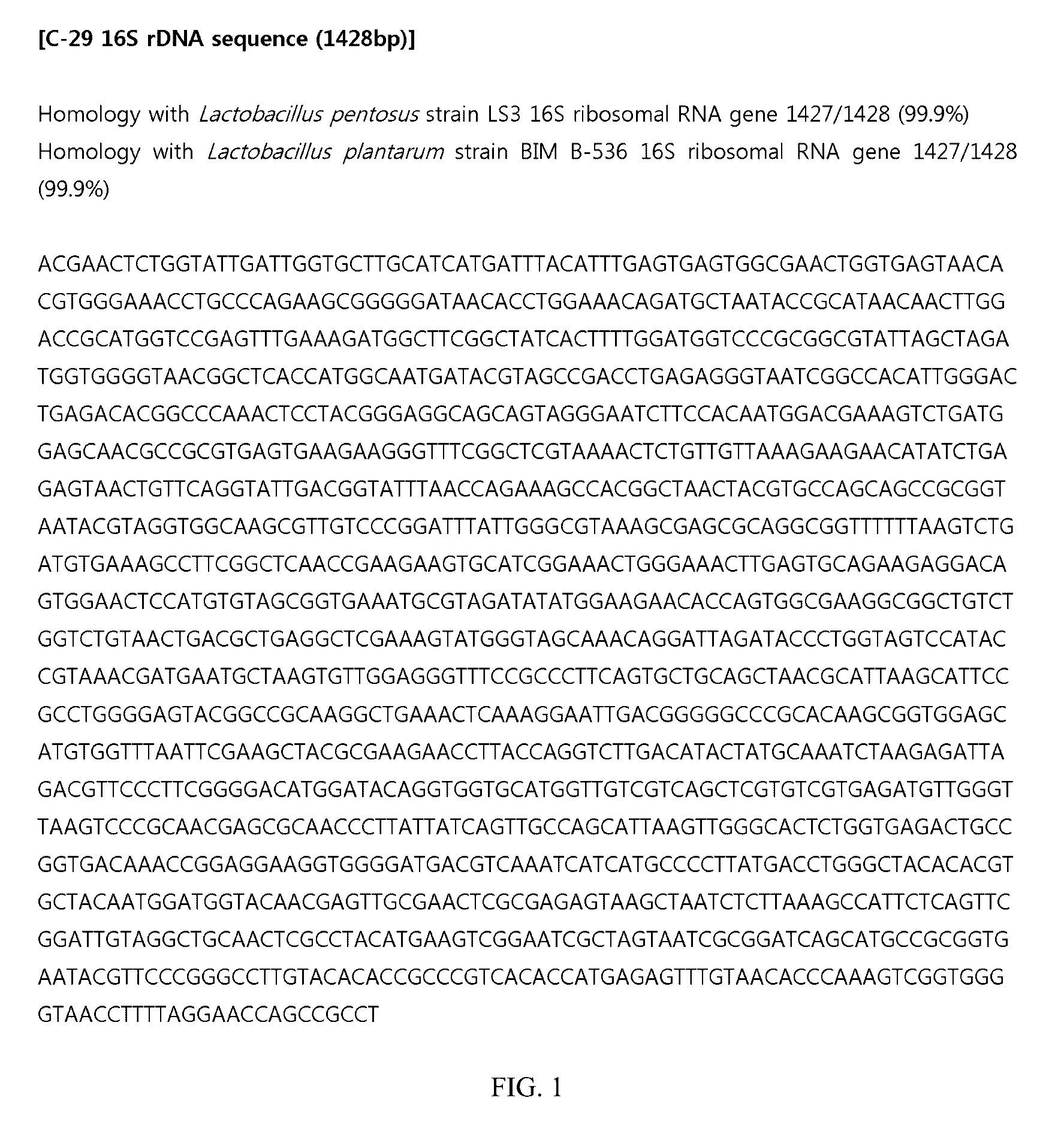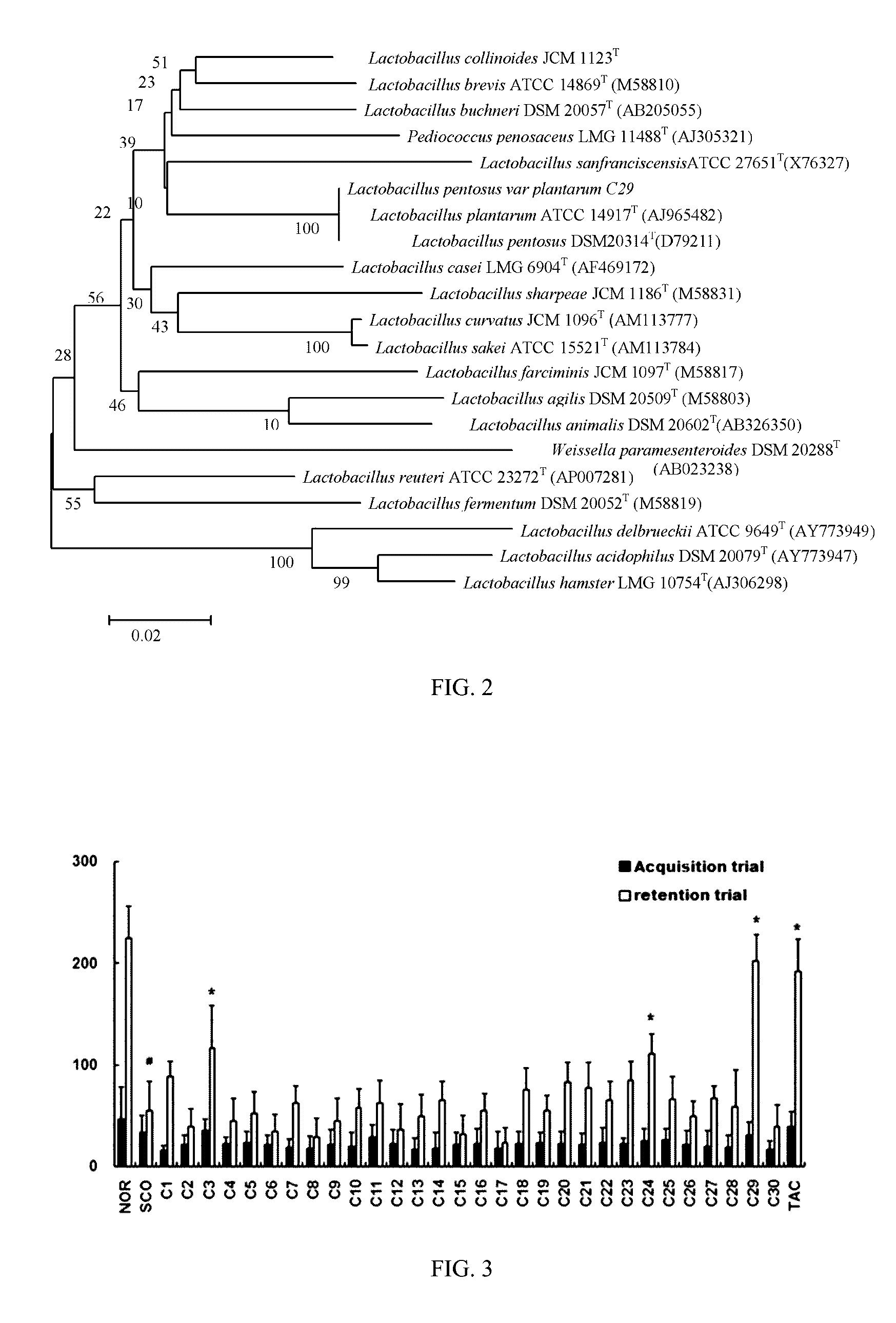Lactic acid bacteria capable of preventing and/or treating senescence and dementia
a lactic acid bacteria and senile disease technology, applied in the field of lactic acid bacteria capable of preventing and/or treating senescence and dementia, can solve the problems of increasing the morbidity rate of diseases, enormous medical expenses, and social problems of rapid growth of senile diseases such as dementia, and achieve the effects of preventing or treating aging, and superior effects on preventing and improving aging and dementia
- Summary
- Abstract
- Description
- Claims
- Application Information
AI Technical Summary
Benefits of technology
Problems solved by technology
Method used
Image
Examples
example 1
Isolation of Lactic Acid Bacteria
[0073]Cabbage Kimchi was suspended in MRS broth, the supernatant thereof was inoculated on MRS agar medium, and then, the medium thereof was anaerobically cultured at a temperature of 37° C. for 24 hours. Since then, the colony being grown out was selected and gram-stained, and 16S rDNA thereof was analyzed, and then a lactobacillus strain was isolated.
[0074]In addition, human feces were suspended in GAM broth (Nissui Pharmaceutical Company, Ltd., Japan), the supernatant thereof was inoculated on BL agar medium (Nissui Pharmaceutical) and then, the medium thereof was anaerobically cultured at 37° C. for 48 hours. Since then, the colony being grown out was selected and gram-stained, and 16S rDNA thereof was analyzed, and then, the lactobacillus and Bifidobacterium strains were isolated.
[0075]The isolated strains are as follows:
[0076]1) Lactic acid bacteria used by isolating from Kimchi[0077]Leuconostoc mesenteroides C1[0078]Leuconostoc kimchii C2[0079...
example 2
Identification of Anti-Dementia Effects
[0108]In order to identify lactic acid bacteria having anti-dementia effects among 30 lactic acid bacteria isolated from Kimchi and feces, an experiment was performed by using the above-described C1 to C30 strains and laboratory animals.
[0109]All animals used in the experiment were the male ICR-based mice (28 to 30 g), and the experiment was performed in accordance with Guide for the Care and Use of Laboratory Animal (NIH publication No. 85-23). 5 and 6 laboratory animals were housed in a cage and were leaved to freely access to the food. The temperature in the cage was 23±1° C., the moisture was 60±10%, and 12 hours of day and night (07:30˜19:30) were always maintained.
2-1. Passive Avoidance Task Test
[0110]An experimental box (50×15×40 cm, electrofiable frid floor) as an experimental equipment was divided into two sections by using a partition, and it is designed so that when entering one side into the opposite side via a small entrance, the e...
example 3
Identifications of Anti-Oxidation, Anti-Aging and Anti-Dementia Effect
[0122]In order to identify the anti-oxidation, anti-aging and anti-dementia effect, three lactic acid bacteria C29, C3, C24 (1×109 CFU, respectively) were administered for five days for 12 weeks, and the anti-aging effect of the lactic acid bacteria and aging-associated gene AKT, FOXO3, NF-κB (p65), mTorr phosphate body in a large intestine that the progress of oxidation reaction is fast, were measured. Beta-actin was measured as a comparative gene. Also, the memory improvement effect was measured.
1) Lipid Peroxide Analysis
[0123]To 100 mg of the large intestine tissue of the laboratory animal, 250 μl of RIPA buffer containing protease inhibitor cocktail was added to homogenate. Thereafter, it was centrifuged for 15 min at 4° C., 13000 rpm, and then the surfactant was used in the lipid peroxidation analysis while storing −80° C.
[0124]The lipid peroxidation degree in the large intestine tissue was analyzed by using ...
PUM
| Property | Measurement | Unit |
|---|---|---|
| weight | aaaaa | aaaaa |
| weight | aaaaa | aaaaa |
| weight | aaaaa | aaaaa |
Abstract
Description
Claims
Application Information
 Login to View More
Login to View More - R&D
- Intellectual Property
- Life Sciences
- Materials
- Tech Scout
- Unparalleled Data Quality
- Higher Quality Content
- 60% Fewer Hallucinations
Browse by: Latest US Patents, China's latest patents, Technical Efficacy Thesaurus, Application Domain, Technology Topic, Popular Technical Reports.
© 2025 PatSnap. All rights reserved.Legal|Privacy policy|Modern Slavery Act Transparency Statement|Sitemap|About US| Contact US: help@patsnap.com



